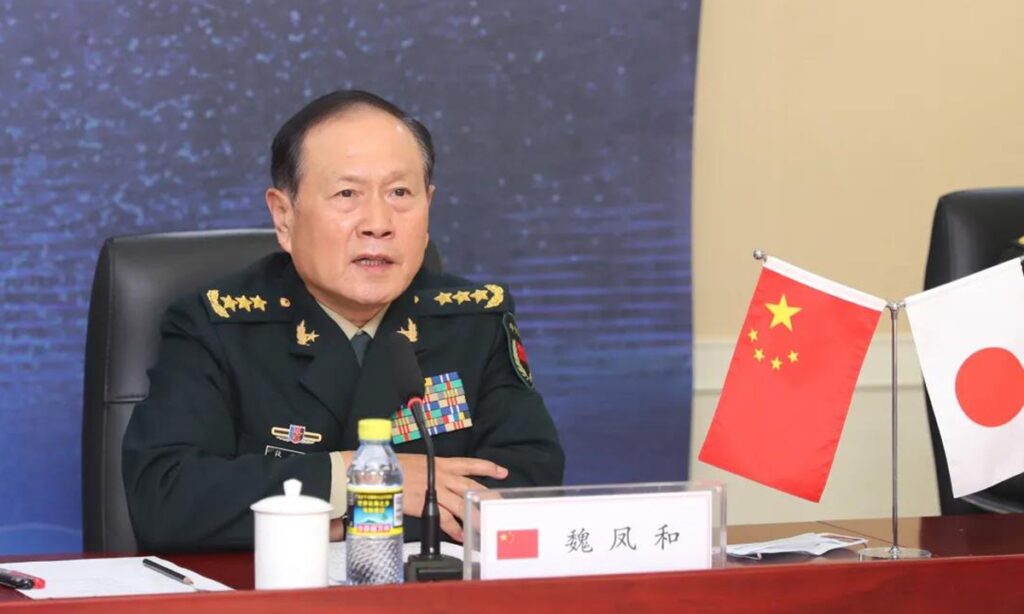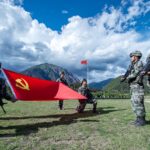Chinese State Councilor and Defense Minister Wei Fenghe told Japanese Defense Minister Nobuo Kishi on Monday that Japan should face squarely up to and learn from history, and that China will resolutely safeguard its territorial sovereignty and maritime rights in the East China Sea and the Diaoyu Islands, shortly after Japanese media reported that Japan recently conducted an exercise under the assumption that “foreign forces” occupied the Diaoyu Islands.
The drill, exposing Japan’s right-wing militarist ambitions and its failure to reflect on history, was obviously a provocation targeting China, as Japan tries to play a role in the US’ attempts to contain China, analysts said.
During the video conference on Monday in an arrangement with Kishi, Wei said that China and Japan should enhance strategic mutual trust, deal with contradictions and differences properly, and realize win-win cooperation, according to a statement the Chinese Defense Ministry released on Monday.
On the issues concerning the East China Sea and the Diaoyu Islands, China will resolutely safeguard its territorial sovereignty and maritime rights, Wei said, noting that both countries should have their eyes on the overall situation of bilateral relations, and make efforts to keep the East China Sea situation stable.
Japan must face squarely up to history and learn lessons from history, and this is the right attitude and the smart choice, Wei said.
Chinese and Japanese defense authorities should enhance high-level exchanges and practical cooperation in order to manage risks and prevent the escalation of differences, Wei said, as he also explained China’s principles and positions on the situation in the Asia-Pacific region, the Taiwan question and the South China Sea issue.
Kishi said that enhancing defense exchanges and cooperation between the two countries are of significance to the development of bilateral ties and maintaining regional stability, as Japan is willing to build constructive, stable Japan-China relations together with China.
The meeting comes shortly after Japan’s Kyodo News reported on Monday that Japan’s Self-Defense Forces, Japan Coast Guard and police held a two-day drill from November 20 at an uninhabited island in Nagasaki Prefecture with land features resembling one of the islets that makes up the Diaoyu Islands in the East China Sea.
The exercise was aimed at improving the cooperation among organizations including the Self-Defense Forces and the coast guard to prepare for “gray zone” situations that stop short of full-fledged military attacks on Japan, Kyodo News reported, citing several Japanese government sources.
Citing the Japanese government, the report said the exercise was “not intended for a specific island or a country.”
However, Chinese experts said the drill obviously pointed at China, as the Diaoyu Islands have been China’s inherent territory since ancient times.
Recently, the China Coast Guard organized normal patrol missions within the 12 nautical miles of the Diaoyu Islands to safeguard China’s sovereignty, and Japan wanted to deter the Chinese coast guard vessels with the drill, Zhang Junshe, a senior research fellow at the Naval Research Academy of the People’s Liberation Army (PLA), told the Global Times on Monday.
Near the Diaoyu Islands, Japan normally only uses coast guard ships to face China’s coast guard ships, but it added warships of the Self-Defense Forces in the mock drill, Zhang pointed out, noting that this is a provocation aimed to threaten China.
However, Japan cannot achieve its goal, and China will resolutely safeguard its sovereignty and territorial integrity, Zhang said.
Japan has been ramping up military preparations against China.
On Wednesday, vessels from Japan’s Maritime Self-Defense Force and the Japan Coast Guard held a joint exercise near the Izu Islands, in which the Japanese ships “prevented” Chinese vessels from approaching the simulated Diaoyu Islands, Japanese newspaper the Yomiuri Shimbun reported on Thursday.
Japanese and US militaries have drawn up a draft joint operation plan that would enable the setting up of an attack base along the Nansei island chain in the country’s southwest in the event of a Taiwan contingency, Kyodo News reported on Thursday.
Not only that, the cabinet of Japanese Prime Minister Fumio Kishida approved Friday a defense budget of 5.40 trillion yen ($47 billion) for fiscal 2022, setting a record high for the eighth consecutive year, to advance the development of new technologies to face China, Kyodo News reported on the day.
Japan’s right-wing forces are aiming to hype the “China threat theory,” so the country can expand defense funding, while also strengthening the US-Japan Alliance in the US’ Indo-Pacific strategies, Wei Dongxu, a Beijing-based military expert, told the Global Times on Monday.
China needs to pay attention to Japan’s aggressive attempt at military expansion, and be careful if its right-wing forces launch a Pearl Harbor-like surprise attack, Wei Dongxu warned.
Another Chinese military expert, who requested anonymity, told the Global Times on Monday that Japan is trying to follow the US’ lead in containing China by hyping the Diaoyu Islands issue and actively attempting to interfere in the Taiwan question in order to gain more US support, using this excuse to develop its military strength and break away from the pacifist constitution.
Japan should reflect on history, and it should not allow militarism to revive and repeat the disaster of World War II, the expert said.
The PLA Navy’s Liaoning aircraft carrier battle group apparently just wrapped up its far sea training in the West Pacific after it was spotted returning to the East China Sea via the Miyako Strait on Saturday, Kyodo News said in a separate report on Monday, citing Japan’s Ministry of Defense Joint Staff.
According to Japanese reports, the Chinese aircraft carrier group crossed the Miyako Strait and entered the Pacific Ocean on December 16, where it conducted intensive exercises involving takeoffs and landings of vessel-based fighter jets and helicopters in international waters southeast of Japan, before returning.
Chinese military experts reached by the Global Times said the aircraft carrier Liaoning‘s exercises are routine and don’t target any third party, but at the same time, the drills must have been carried out in a realistic combat scenario.
The West Pacific is an important potential battlefield if foreign forces like the US and Japan militarily interfere in the Taiwan question, as Chinese aircraft carriers could take positions in that area and fend off foreign forces, while also surrounding the island of Taiwan from the east, analysts said.
Wei Fenghe Photo:MOD



